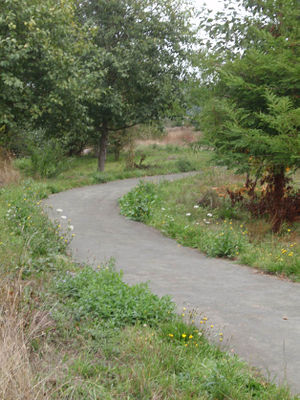Anonymous1 (talk | contribs) No edit summary |
JaquelynJS (talk | contribs) No edit summary |
||
| Line 1: | Line 1: | ||
{{115inprogress|December 12th, 2008}} | {{115inprogress|December 12th, 2008}} | ||
[[Image: | [[Image:path1.jpg|right|thumb|Potowat pine resin pavement]] | ||
===Potawot Paths=== | ===Potawot Paths=== | ||
Potawot Health Village is located on 40 acres of land in Arcata, CA. Approximately two miles of paths have been constructed on their land in order for the community to enjoy the conservation land that surrounds their main facility. Instead of applying conventional asphalt to the land, a natural alternative, pine resin pavement, was used to create the pathways. | Potawot Health Village is located on 40 acres of land in Arcata, CA. Approximately two miles of paths have been constructed on their land in order for the community to enjoy the conservation land that surrounds their main facility. Instead of applying conventional asphalt to the land, a natural alternative, pine resin pavement, was used to create the pathways. | ||
Revision as of 18:02, 29 October 2008

Potawot Paths
Potawot Health Village is located on 40 acres of land in Arcata, CA. Approximately two miles of paths have been constructed on their land in order for the community to enjoy the conservation land that surrounds their main facility. Instead of applying conventional asphalt to the land, a natural alternative, pine resin pavement, was used to create the pathways.
Material Description: Pine Resin Pavement
What is it made of?
Pine Resin pavement is a combination of regular aggregate, or crushed rock, sealed together with pine rosin and pitch from pine trees (Product Review, 1999). How is it Processed
This natural alternative to asphalt isn’t mixed and poured hot as regular asphalt is, but instead mixed together through a cold process. Water and the pine emulsion are mixed together with water and then laid out where it is needed. The mixture is then compacted and left to set using conventional methods, such as steamrollers in larger areas. Instead of the product setting by cooling, it sets through evaporation of water leaving the mixture. (Product Review, 1999)
What is the final product?
Much of the energy required to lay normal asphalt is avoided because the mixture does not have to be heated up, saving precious fossil fuel resources. Also, because the adhesive material is made of tree resin rather than normal asphalt, there pavement doesn’t contain any VOC’s of PAHs. (Product Review 1999) The final product is similar in appearance to asphalt in texture and thickness but can vary in color. The pine resin transparent and takes the color of the aggregate.
Durability
The strength of pine resin pavement varies due to the quality of application, site location and actual pine resin product used. NaturalPave XL, a pine resin distributor put it's product to the Marshall Stability Test. This test heats up the pavement to 140 F and then observes how the pavement responds to heavy weight applied. NaturalPAVE XL withstanded "8,000 to 18,000 pounds" (NaturalPAVE XL, 2008). The document also stated that the typical Marshall Stability results for conventional asphalt are generally 4,000 to 6,000 pounds.
Other studies have claimed that resin pavement has three times the compressive strength then that of asphalt and that resin pavement is 'highly water-resistant". (Product Review, 1999)
As impressive as these finding are, the possibility for large scale use seem to be limited to low traffic areas as "cold mix is certainly not for roads subjected to medium to heavy traffic." (Dooley, 2008)
Cost
According to the EPA, Resin Pavements are $3/square foot for the material and installation.
Comparison to Conventional Asphalt
Pine resin pavement is a appropriate alternative for asphalt. However, asphalt is the conventional way of paving surfaces and is may be cheaper and easier in the short run. However, asphalt also has many negative externalities associated with it. Since it is a hot mix, it takes energy from fossil fuels to heat it up. Once it is heated it emits harmful air pollutants into the air, such as formaldehyde. (EPA, 2003) Below are facts to keep in mind about pine resin pavement.
| Advantages | Disadvantages |
|---|---|
| - High solar reflectivity: it reflects more sunlight so the pavement absorbs less heat. | - Limited to use to low traffic areas |
| - Not composed of petroleum products | - High Cost |
| - Materials are natural and renewable | Labor Intensive |
| - Application is not energy intensive | Certain outdoor temperatures are needed for proper finishing |
| Emits no air pollution | Technology is new, product and information are hard to find |
| Not composed of Toxic Chemicals | Companies that sell the pine resin don't apply it as well |
References
- Dooley, Erin E. “New Default for Asphalt?” Environmental Health Perspectives vol.116, no 9, pg 379, 2008.
- “Paving Without Asphalt or Concrete”Product Review: Environmental Building News. Nov. 1, 1999.
- NaturalPAVE® XL “Technical Bulletin-Pavement Preformance Testing.” Soil Stabilization Products Company, Inc.
- NaturalPAVE® XL “An aesthetic, environmentally friendly alternatice to asphalt”. Soil Stabilization Products Company, Inc.
- "Resin Pavement: Cool Pavement Product Information" Environmental Protection Agency, US Government.Oct. 2008. [1]
"National Emission Standards for Hazardous Air Pollutants: Asphalt Processing and Asphalt Roof Manufacturing" Environmental Protection Agency, US Government Federal Register. May 17, 2003 [2]